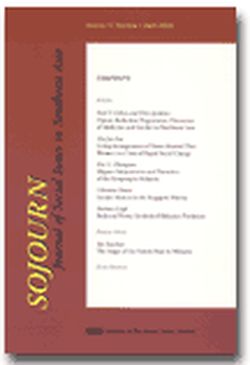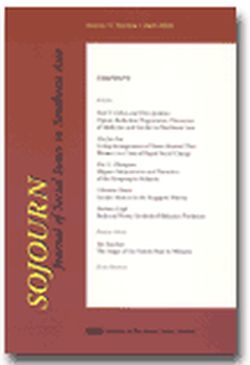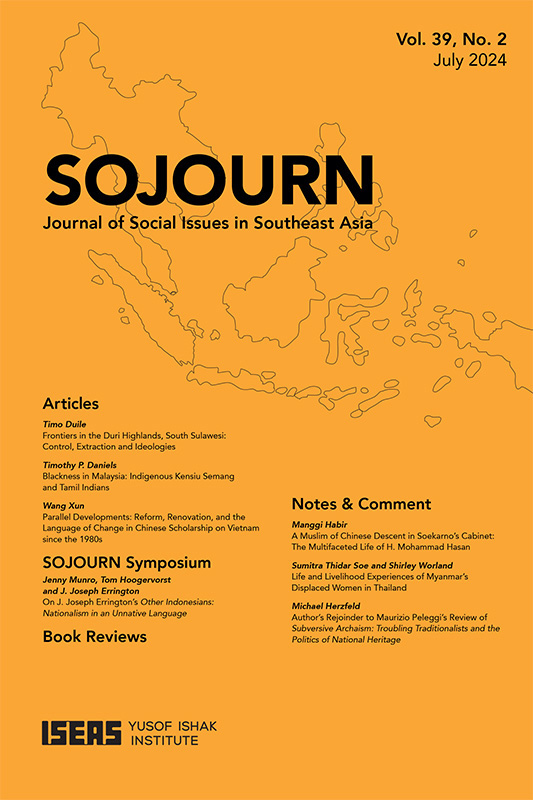SOJOURN: Journal of Social Issues in Southeast Asia Vol. 23/2 (October 2008)

Date of publication:
October 2008
Publisher:
Institute of Southeast Asian Studies
Number of pages:
141
Code:
SJ23/2
Contents
-
SOJOURN: Journal of Social Issues in Southeast Asia Vol. 23/2 (October 2008)
[Whole Publication] -
Preliminary pages
- ARTICLES
-
Perspective versus Practice: Women's Leadership in Muhammadiyah, by Kurniawati Hastuti Dewi, author see abstractThis study examines Muhammadiyah's views on women's leadership that play a significant role in determining whether the demand for women's leadership in the movement, based on the case of the 45th Muhammadiyah Muktamar in July 2005, will be met. This paper presents the discrepancy between these perspectives and contemporary practices, and assesses the endorsements of the textual approach for understanding divine messages on women, the male hegemonic sentiment, and the rejection of the affirmative action rule for accommodating women in the Muhammadiyah central board. Findings suggest that the views of Muhammadiyah followers have shifted towards favouring women's leadership, and are presently a crucial factor in improving the status of women.
-
Seeking Self-Worth, Fighting Boredom: Why Women Choose to Work in Catbalogan, Samar, Philippines, by Gabriel Munoz Gan, author see abstractThe island province of Samar, the third largest in the Philippines, was classified in 1996 as a third-class province. At the same time, its newly established city of Catbalogan is categorized as first class. This study presents the factors affecting Catbalogan women before they join the labour force. The female labour force participation rate of Catbalogan is at almost eighty per cent, while that for the nation is just fifty per cent. Both employed and unemployed women perceive that their gender, age, civil status, and earnings of their husband and extended family members are insignificant factors in seeking employment. On the other hand, educational attainment, household status, and expected salary are considered very important factors. Catbalogan women seek employment primarily because they want to realize self-worth; this factor is followed by family-related reasons and boredom. Discouraged workers leave the labour force mainly because of a lack of motivation, failure in finding work, and family reasons.
-
Islamic Resurgence and the Ethnicization of the Malaysian State: The Case of Lina Joy, by Timo Kartteinen, author see abstractLina Joy, born Azlina Jailani, a Malaysian convert from Islam to Christianity, managed to change her name in her Malaysian identity card (MyKad ) but her religion remained listed there as Islam. What does the case of Lina Joy tell us about Malaysian society? In this paper, the case is interpreted against the backdrop of the global resurgence of Islamic movement where the field is set by liberal and neofundamentalist modern interpretations of Islam as opposed to traditional, "pristine" Islam confined to traditional communities, societies and cultures. In Malaysia, the distinction between 'modern' and 'traditional' interpretations of Islam is reflected in the different positions taken on the Lina Joy issue. On the one hand, feminist and women's movements, among other 'grass-root' movements, clearly finds justification in the western discourse of human rights, for example, where "modern" western concepts are used to defend the rights of women as well as Muslims. On the other hand, spokesmen of the Malay majority seem more comfortable with the rhetoric of traditional Islam mixed with Malaysian political considerations. In addition, in Malaysia, where Malay identity is identical with Muslim identity, the resurgence of Islamic movement has implications on the nature of majority Malay rule, i.e., on the ethnicization of the state.
-
Comparing Local Silk Textiles: The Thai-Lao Matmii and the Japanese Tumugi Kasuri, by Keiko Yukimatsu, Songkoon Chantachon, Souneth Pothisane, Wissanu Kobsiriphat, authors see abstractThis comparative study focuses on six aspects of local Thai and Japanese silk textiles - the patterns and designs, materials, local wisdom, cultural values, process of producing, and beliefs. The textiles studied are the Thai-Lao silk Matmii from Maha Sarakham Province in northeastern Thailand and the silk Tumugi Kasuri called Ushikubi Tumugi from Ishikawa Prefecture in Japan. The study explores the functions of these local traditional textiles and examines the cultural changes that influenced patterns, techniques, and use over the centuries. It is demonstrated that both textiles, as traditional crafts, reflect the identity, heritage, and dignity of local weavers and local people. The legacy represents a visible historical record of changes in society and that society's adjustment to new environments. Thai and Japanese local silk textiles express so many facets of local society that they are often referred to as symbols of that society.
-
Longing for Japan: The Consumption of Japanese Cultural Products in Thailand Noboru Toyoshima, by Noboru Toyoshima, author see abstractScholars of media and cultural studies have theorized about the popularity of Japanese cultural products in Asia from the viewpoint of globalization but they have tended to avoid approaching the issue empirically. This article is an attempt to delineate the consumption of Japanese cultural products in Thailand. Questionnaire results of 677 secondary school students in Thailand and field notes from my participant observations in cultural events in Bangkok are provided to support the discussion. By looking at each cultural product closely, we may gain deeper understanding of the mechanism by which Japanese cultural products are popularized in Thailand.
- BOOK REVIEWS
-
Book Review: Singapore: The State and the Culture of Excess, by Souchou Yao, by Kenneth Paul Tan, author
-
Book Review: Civil Society and Democratization: Social Movements in Northeast Thailand, by Somchai Phatharathananunth, by Pattana Kitiarsa, author
-
Book Review: Views of Seventeenth-Century Vietnam: Christoforo Borri on Cochinchina and Samuel Baron on Tonkin, edited and annotated by Olga Dror and K.W. Taylor, by Nola Cooke, author
-
Book Review: Vientiane: Transformations of a Lao Landscape, by Marc Askew, William Logan, and Colin Long, by Warren Paul Mayes, author





